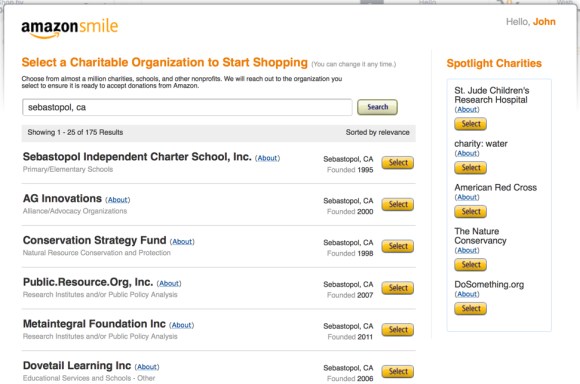The AmazonSmile program, where a small percentage of sales is given to a designated nonprofit, is a nice sentiment but will likely prove a net loss for most participating nonprofit organizations.
The sentiment is admirable – provide exposure to nonprofits on the popular shopping site and donate a portion of sales to worthy causes. Unfortunately, for years I have seen nonprofits waste time, energy and hope on similar online charity malls, where supporters must shop through a certain website that then gives portions of proceeds to participating organizations. My issues with them – and with AmazonSmile – are that they are not very generous, they only benefit nonprofits with a large supporter base and they usually have a negative overall ROI for organizations that participate.
How It Works
I first heard about AmazonSmile when Beth Kanter mentioned it on Facebook. At smile.amazon.com you can choose a charity. That charity then gets a donation based on how much you spend while shopping.
$5 of every $1000
Through Amazon Smile, 0.5% of a shoppers total purchase is donated to a designated nonprofit. That means I would have to spend $1000 to generate a $5 donation. No matter what I spend, the resulting donation amount is not as generous as I would like to see. Considering the amount of profit that the company makes on each purchase, 0.5% seems like less than a pittance. The real goal is to get people to buy more, thinking they are “doing good”, when in fact the mostly “Made in China” junk they buy does more harm to the environment than the donation they generate.
Rather than an altruistic gesture, it is more like the classic baiting technique used by retailers for years. Sales, “Buy one, get one free” or “Free gift with purchase” promotions all work on the principal that once they get you into their shopping environment with the bait, you will not just buy the sale item but will spend much more than the retailer loses through the promotion. Same goes with the fake “feel good about your purchase” that Amazon is selling.
Despite being positioned as a donation, since this is actually a purchase, donors don’t get the tax benefit. A read through the “About Amazon Smile” section reveals that “Donations are made by the AmazonSmile Foundation and are not tax deductible by you.“ So not only does Amazon get more business, they get the tax deduction too.
If you want to support a nonprofit, give to them directly and get the tax deduction yourself. Don’t give a corporate giant that is swimming in money more money and a tax break because they fool you into thinking you’re doing something good.
Advantage: Goliath
In order for this promotion to generate any serious dollars, nonprofit organizations need to activate many supporters to spend thousands of dollars. It is doubtful that any but the largest nonprofit brands will be able to do this. Whether large in size or in name recognition like American Red Cross or DoSomething.org, the advantage will go to the larger and more well known brands rather than smaller, less well known nonprofits. I have nothing against the better known brands, I just see the fake “Smile” program as doing little to mitigate the advantages of larger nonprofits. Amazon doesn’t care, the larger nonprofits bring in more consumers, why should they care if small nonprofits get short shrift?
This is akin to the controversy over Popularity Contest Philanthropy that arose in 2010 around contests by Pepsi, Chase Community Giving and others. See also this interesting study that mentions the costs vs. benefits of one such campaign. When I first reviewed the smile page, I saw only large national brands like Nature Conservancy and charity:water on the main page, so I did a search for my small town in Northern California to see if any local agencies were listed. While local nonprofits came up in the search, it says Amazon will contact them to see if they want to participate.

Seems like a way to get customers to provide Amazon with an excuse to contact nonprofits in order to enlist the organizations help in promoting Amazon, with little return to the nonprofit on their effort.
Negative ROI
Many charity malls have required that nonprofit staff spend considerable time setting up the system, marketing and promoting their participation. To be fair, the reports I have heard say that it is easy to sign up to participate in AmazonSmile. But the resources used to sign up is only part of the equation.
If an organization decides to promote their participation, time is spent in writing up and distributing the message. If on average a staff person spends 2 hours in setup, promotion and data management and if that person is paid $20 per hour, there is $40 in investment. Supporters would need to spend $8000 to generate the $40 donation needed to break even. Even just posting an ad on the nonprofit website – which of course Amazon makes it easy to do – takes up valuable real estate. There are other intangible costs as well including diluting the year-end fundraising message of the organization and the disappointment that comes with the realization that the effort did not pay for itself.
 On a more global level, one could argue that using Amazon results in a net loss for the planet that is not offset by the donations generated. Greenpeace has criticized Amazon, among others, for “heavy use of coal-derived power for their massive data centers.” Using Amazon instead of shopping locally does not support your local small business community and likely results in your purchase having a larger carbon footprint because of the shipment from China and the delivery. Convenient, yes, but conscientious? Not so much.
On a more global level, one could argue that using Amazon results in a net loss for the planet that is not offset by the donations generated. Greenpeace has criticized Amazon, among others, for “heavy use of coal-derived power for their massive data centers.” Using Amazon instead of shopping locally does not support your local small business community and likely results in your purchase having a larger carbon footprint because of the shipment from China and the delivery. Convenient, yes, but conscientious? Not so much.
I agree that there is a public relations value to participating organizations in having Amazon reminding shoppers about those worthy nonprofits. I also think Amazon benefits by way of association much more than they will ever pay out in donations.
Solutions
From my point of view, a more equitable way of helping nonprofits would be for Amazon to choose a group of charities – a mix of smaller and medium-sized organizations – to receive donations. They then would distribute 5% of their profits earned annually evenly among those organizations. Same net PR gain for Amazon but greater impact on organizations that may be less well-known. Even include some of the big names, as long as there is a more even playing field.
But that doesn’t seem of interest to Amazon. They don’t really want to help nonprofits very much, only when it also means more profits to them. Why make a real impact on social issues with thoughtful philanthropy when you can con your customers into buying more by pretending to help?
I would welcome having my theory of most organizations losing money be disproved, but it hasn’t happened in the fours years since 2015 I’ve been following the program. I have heard from participating organizations that their results in dollars gained vs. effort spent is almost always a net loss. It is a financial boon to a very few – the largest, most well known organizations. Regrettably, nonprofits are so under-resourced and desperate for any donation, they waste their resources in hopes they will make money and take the donation even if they lose money on the deal.
A program that is not real philanthropy, that preys on the psychology of people who want to do good and that wastes the resources of nonprofits? Nothing to smile about – Hence the frown :(.
Updates Since Publication:
Since posting this article in I have heard from a nonprofit professional, Sandy Masuo of the Greater Los Angeles Zoo Association, who agreed about the downsides, and shared what I think is an excellent point – “The nonprofit I work for recently signed onto this program, and I’m trying to figure out a way to make $5 on every $1,000 seem inspiring to the many middle class families who are (our) members :-/”.
Since the program started, Amazon has made some reporting improvements to the program but is still not completely transparent. Foundations have ways to improve their transparency through programs like Glass Pockets.
As I imagine Amazon hoped, nonprofits who are desperate for adequate funding have slapped the Amazon (Smile) logo onto many of their websites, effectively giving Amazon free advertising, whether any donations come in or not. That free advertising, plus the fact that folks often spend more money when they think it will help a good cause, has made Amazon much more money than they have or will ever give back.
Amazon continues to use nonprofits so they can increase their profits, not for any real social good they are committed to promoting.
I remain hopeful that Amazon will find better ways to use their resources to intelligently support the nonprofits in our global community.

Clark
$1 for every $200 is still not bad (and that’s a better way to sell it to people who may spend $100-200 a year, than $5 for every $1000). It’s the equivalent of throwing coins in a Salvation Army jar. Individually, it’s small, but collectively it can count.
Nancy Logan
They also should be allowing Smile to be on their mobile app which is the growth area of spending, but they don’t. They really need to update that to align with regular website. When you ask Amazon employees they say they are ‘working on it’. ahem…oh yeah….
Zac Woonsam
Greetings,
As a small nonprofit, we are losing the fundraising battle with Amazon. We were founded in 2017 and enrolled in the “Smile” program in October of 2018. With $100 in investment during this year and last year’s holiday season, we’ve made $36.00. Thirty dollars of that was raised from the purchases of our organization. Amazon has received free advertising on our website because of the “Smile” link. Unfortunately, people won’t sign up and enter their passwords on a link that belongs to an unknown nonprofit. In this day and age, I don’t blame them. Even though Amazon has donated over $100,000,000 to nonprofits, Amazon has cost our organization money with a donation platform that is truly flawed and can only be effectively utilized by large, well established nonprofits. I would love to know which nonprofits received the majority of the funds raised.
U. R. Loved
@Zac Woonsam “I would love to know which nonprofits received the majority of the funds raised.” Ditto, and then let it be published far and wide.
Jake D
My guess would have been that Amazon gets some kind of a tax break for making those donations.
Donna Ruzicka
Thank you for this information. I was curious what the percentage of the donation was, so when I googled it, gratefully, your site came forward. I don’t order much online but was considering something if the small non-profit, a Catholic Seminary, would benefit. Not much benefit. Very grateful for your information.
donna
Larry
I didn’t read the article (I have a problem with my vision, and reading online articles carefully is difficult.) One thing that I have discovered in talking to peeople who are very proud of their “Smile” donations, is that it causes them to make less in real donations to that charity. They have no idea that the amount actually being donated is so miniscule.